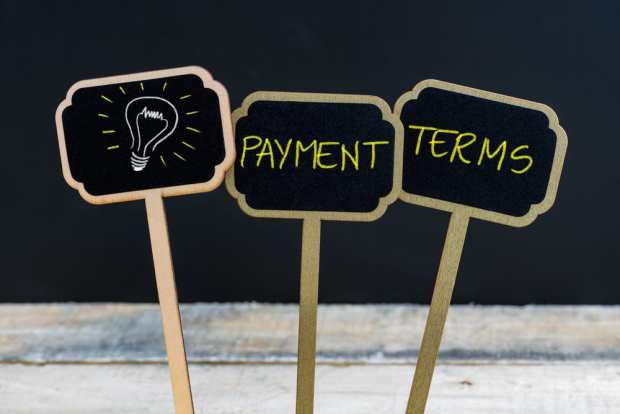The Pitfalls Of Unsustainable Supplier Payment Terms

Lengthening payment terms between corporate buyers and suppliers have built up a bad reputation in the B2B space — thanks, in part, to payment practices deployed by large entities like Carillion in a demonstration of buying power abuse over smaller vendors.
However, the practice of negotiating B2B payment terms is not about companies getting away with delaying invoice payments as long as possible. At least, it’s not supposed to be, says Brian Shanahan, founder of working capital advisory firm Informita.
Shanahan also formed a database of supplier payment terms, Termscheck, as a way to provide visibility into existing agreements between buyers and suppliers, and to inform future corporate customers’ payment-term negotiations moving forward. Such a solution may raise concerns about how companies are wielding their buying power to lengthen payment terms, but when organizations focus on the importance of the buyer-supplier relationship, and prioritize the sustainability of payment agreements, both sides can win.
“It has to be beneficial to both sides,” Shanahan told PYMNTS of the process of negotiating supplier payment terms. “The buying company wants longer payment terms, but the seller wants to make sure they’re paid on time. Otherwise, customers are not reliable, and it endangers the financial investment they’re making in the relationship long term.”
While regulators and industry participants have raised the issue of longer payment terms for small suppliers as of late, Shanahan explained that doing so actually makes little financial sense for large companies. Small businesses (SMBs) make up only a fraction of a large organization’s overall procurement spend volume, so risking a negative reputation and supplier relationship for the sake of minimal capital expansion isn’t the smartest cash flow move.
Negotiating payment terms with larger suppliers, however, can offer cash flow predictability and reliability for both customer and vendor, he said, but it must be done correctly. That means customers must stick to agreed-upon terms (i.e., no late payments), and must wield their buying power appropriately and responsibly (i.e., no outlandishly long payment terms).
Of course, the reality of today’s market is far from ideal.
A History Of Lengthening Payment Terms
Shanahan explained that B2B payment terms have gradually lengthened over the years, particularly in developed markets like the U.S., and in the wake of the 2008 global economic downturn. In many respects, payment terms lengthened simply because corporate customers were forced to do so to stay afloat. The problem, he said, is that, amid the economic rebound, those payment terms never bounced back to pre-downturn time frames.
Today, with concerns of a recession ahead, there is again the risk that organizations will stretch out payment terms even longer. In the U.S., for instance, it’s already common to see 120-day payment terms. Shanahan warned that, if and when another economic downturn emerges, companies cannot stretch their payment terms out any longer.
“Whatever you do,” he said, “it has to be done in a sustained way. Otherwise, it could spell big financial trouble.”
Not only are ultra-long payment terms an unsustainable strategy, but an over-reliance on supply chain finance can be as well, he explained.
In the U.S., low interest rates have opened the supply chain finance doors for organizations to extend payment terms, and offer affordable supplier financing so vendors can continue to ensure their own healthy cash flows. However, the threat and expectation of rising interest rates can make this strategy unsustainable.
“Particularly in the U.S., large corporates have implemented supply chain finance programs quite aggressively, and more often than not, they’re extending out terms to 120 days — which is very long, indeed,” Shanahan said. “But that effectively means the [vendor] has to pay a price to get their cash, or has to wait longer for it. There’s no security in the scheme.”
Rising interest rates mean supply chain finance would no longer be affordable for many firms. There is also the risk that a bank or other finance provider would back out of an agreement, or a corporate customer would be acquired, leaving vendors stuck with that 120-day payment-term agreement.
“If you look at some large U.S. corporations, particularly the ones that have gone the supply chain finance route, they’re stretching balance sheets to the limit,” Shanahan said, adding that many companies are paying back debt or issuing share buy-backs with the extended capital float, rather than investing in their organizations. “When they give it back to shareholders or pay off debt, that cash is gone,” he continued, again raising the issue of a lack of sustainable practices, especially with many predicting a recession.
Sustainable Agreements
With organizations increasingly viewing their vendor relationships as strategic partnerships, negotiating payment terms is part of the bigger picture of cash-flow management on both sides of a B2B transaction.
Businesses that use a solution like Termscheck are able to see data offered voluntarily by other businesses about the payment terms they have achieved with their suppliers. This gives a window into whether it would be possible to achieve a 30- or 60-day agreement with a specific vendor, which can often be impossible to know without such a database, said Shanahan.
Yet, organizations need to ensure that whatever agreements, financing programs and payment practices they set into motion are sustainable in the long term, through economic downturns and periods of growth. They must also work for both sides.
“Many years ago, someone said to me, ‘You can talk about relationships all you’d like, but if you don’t pay me, then I don’t have a relationship with you,'” Shanahan recalled. “It’s the fundamental building block of any buyer-supplier relationship.”
